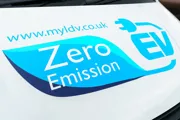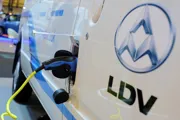Review
We first saw the all-electric LDV EV80 at the CV Show in 2016.
Now, 18 months on, we’ve finally been given the keys to a fully charged EV80 and driven it out on the road.
It seems like a long time coming and, although still relatively un-saturated, there is an increasing number of electric vans creeping onto the market.
Before we get into any depth, let’s cover off the most important fact: range.
LDV says the EV80 can cover 120 miles in between charges and can be recharged in just one hour. This makes it perfect for short-to-medium trips.
On the outside the EV80 looks no different to the standard V80 panel van.
It comes in long wheelbase medium roof spec only; offering a 3.3-metre long load space with a width and height of 1.7-metres. So 10.3 cubic metres of load space to fill.
Because the batteries – mounted under the chassis – eat into the overall weight, payload is restricted to 950kg.
In the cab you are presented with the same dashboard as the regular V80, although the instrument cluster is a tad more high-tech thanks to a digital range display and a battery charge indicator.
The V80 has remote central locking, air conditioning and electric windows. Don’t expect to many frills though. It’s based on a very cheap vehicle and the EV80 gets no additional gear over a standard V80.
Which brings us to price. Bearing in mind a V80 can be had for around £14,000, dropping the diesel engine for an electric motor and some batteries sees the price climb to an eye-watering £60,000.
LDVs official importer in the UK, Harris Automotive, hasn’t officially confirmed this figure yet, but we’re in the right ball park according to its bosses.
If you decide to buy one the Government will give you £8,000 towards it, plus you can discount all the money you’d be spending on diesel and oil changes.
But it still leaves you feeling short-changed when you step inside the cab. Even more depressing is the acceleration – 0-60mph takes 24 seconds.
Our test route covered lots of hilly country lanes and the van felt surprisingly sprightly.
It doesn’t set off with much gusto, even with an empty load, but it offers the typical seamless torque delivery of an electric motor. Total system output is 320Nm, that’s only 10Nm shy of the diesel version.
The battery didn’t discharge at an alarming rate either, it reached the red zone after around 80-miles of driving which, considering our thorough testing on Irish back-roads, is pretty decent.
If the future of electric vehicles were reliant on the EV80 being a success then the Green Party might have a problem.
It will take some time to become cost-neutral, but it does offer a practical solution for small businesses under pressure to be green.
Model tested: LWB medium roof
























